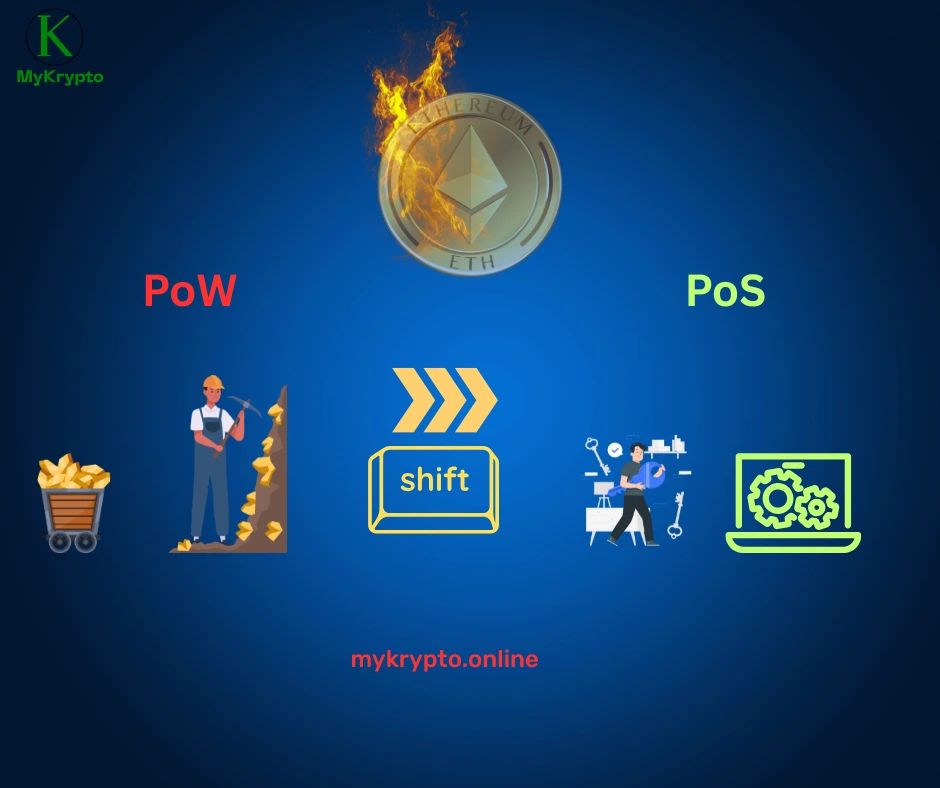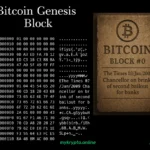The Merge and Beyond: Triple Halving of Ethereum | Monetary Policy
Welcome to MyKrypto!
The Triple Halving of Ethereum is a topic of debate. This blog is primarily intended for Ethereum holders, DeFi users, and investors seeking to understand ETH as a stable monetary asset. But yeah, beginners are also most welcome. Let’s get started now.
Introduction
For years, Bitcoin’s “halving” has been the most significant event in crypto monetary policy. Monetary policy in crypto means – how many tokens are created, destroyed, or locked over time. It’s a pre-programmed, predictable reduction in the issuance of new bitcoin, creating a built-in scarcity mechanism that is central to its investment thesis as “digital gold.”
Ethereum, however, took a different path. Originally inflationary to reward miners for securing the network, its monetary policy was dynamic and often debated. This all changed on September 15, 2022, with an event known as The Merge. Ethereum transitioned from the energy-intensive Proof-of-Work (PoW) consensus mechanism to the staking-based Proof-of-Stake (PoS), cutting issuance by roughly 90% together with EIP-1559’s fee burn, creating a structural path toward disinflation and occasional deflation. This wasn’t just a technical upgrade; it was a fundamental transformation of Ethereum’s economic engine.

The Triple Halving of Ethereum is a powerful metaphor coined to help the crypto world understand three supply-reducing forces working together: (1) the Merge’s issuance cut, (2) EIP-1559 base-fee burns, and (3) large amounts of ETH locked/staked — all of which can act like repeated “halvings” of new supply. It signifies an issuance reduction so profound that it is equivalent to three Bitcoin halvings happening at once. This event has cemented Ethereum’s transition into a potentially ultra-sound asset with a deflationary tendency, forever altering its value proposition and positioning it as a formidable competitor in the store-of-value arena.
For a platform like Ethereum, changes to issuance or permanent removal (burning) directly affect scarcity. Scarcity combines with demand from users and apps (DeFi, NFTs, L2s) to influence long-term value, validator economics, and how users feel about staking/holding ETH.
Two upgrades rewired Ethereum’s Monetary Policy:
-
EIP-1559 (London fork, Aug 2021): introduces a base fee that is burned (permanently removed) when users transact. This made ETH less inflationary in times of high network activity. The Defiant
-
The Merge (Sept 15, 2022): switched consensus to Proof-of-Stake and massively reduced new ETH issuance (block rewards to miners ended; rewards now go to stakers). That lowered annual issuance by ~80–90%. ethereum.org
Combine both and you get a supply dynamic that can (depending on activity) be deflationary — more ETH burned than issued — or at least much less inflationary than before.
What people mean by the Triple Halving of Ethereum
Bitcoin has scheduled halvings every ~4 years (a hard, deterministic cut in miner reward). Ethereum has no single halving date — instead, the Triple Halving of Ethereum is used colloquially to describe three supply-reducing effects that, together, resemble multiple halvings of issuance:
-
Issuance collapse from PoW → PoS (the Merge): new ETH created per day dropped sharply (roughly from ~13k ETH/day pre-Merge to ~1.6k ETH/day post-Merge in many estimates). Investopedia
-
EIP-1559 base-fee burns: during high gas usage, base fees burned can exceed issuance, removing ETH from supply. Over time, billions of dollars’ worth of ETH have been burned. Crypto Briefing+1
-
Large quantities of ETH locked/staked: when ETH is staked, it’s out of the liquid supply (reducing circulating supply pressure), tightening effective availability.
Because all three push supply lower (or reduce supply growth), people sometimes call the net effect a “triple halving” — a helpful mental model, not a single protocol event. CoinGecko, LCX, and multiple educational sites use this framing.
Deep Analysis: Technical Concepts Explained Simply
Let’s break down the key concepts that define Ethereum’s new monetary policy.
1. The Merge: From Miners to Stakers
Proof-of-Work (Old Way): Miners used massive computing power to solve complex puzzles. The winner created the next block and received a block reward (newly issued ETH) plus transaction fees. This issued a lot of new ETH (~13k ETH/day historically), leading to steady inflation.
Proof-of-Stake (New Way): Validators (not miners) “stake” or lock up a minimum of 32 ETH to participate in securing the network. The protocol randomly selects a validator to propose the next block. Other validators attest to its validity. Rewards are given for honest participation. This is far more energy-efficient and requires far less new ETH to be issued as security.
2. The Issuance Cliff: The Triple Halving of Ethereum
The term “Triple Halving” isn’t literal but is a brilliant economic analogy.
Bitcoin Halving: Cuts new issuance by 50% every 4 years.
Ethereum’s Merge: Cut new ETH issuance by approximately 90% overnight. Pre-Merge, around 13,500 ETH were issued daily to miners. Post-Merge, this dropped to around 1,350 ETH issued daily to stakers.
The Math: A 90% reduction is equivalent to three consecutive 50% reductions (0.5 * 0.5 * 0.5 = 0.125, or an 87.5% reduction). Hence, “Triple Halving.”
3. The Fee Burn: Making Ethereum Deflationary
This is the second, and equally important, part of the equation. With the London upgrade (EIP-1559) in August 2021, a mechanism was introduced to burn (permanently destroy) a portion of the transaction fees (gas fees) paid by users.
How it works: Every time a transaction is made on Ethereum, a base fee is burned and removed from circulation forever. Only an optional “priority fee” goes to the validator.
The Ultrasound Money Thesis: When the amount of ETH burned (from fees) exceeds the amount of new ETH issued (to stakers), the net supply of ETH decreases. This makes the currency deflationary.
The Net Issuance Equation:
`Net ETH Issuance = New Issuance to Stakers – ETH Burned from Fees`
When the network is busy and gas fees are high, the burn rate can easily surpass the low issuance, causing the total supply of ETH to shrink.
If you want to know the crypto strategy, then please click on this blog.
Case Studies / Real-World Examples
1. The Post-Merge Supply Shock:
Since The Merge, we have real-time data on ETH supply.
The Counterfactual: Had PoW continued, over 5 million additional ETH would have been issued by now.
The Reality: As of early 2024, the total ETH supply has **increased by only ~324,000 ETH** since The Merge. Under PoW, this number would be vastly higher.
The Deflationary Periods: During periods of high network congestion (like major NFT mints, meme coin frenzies, or DeFi booms), the supply has actually shrunk. For example, during the peak of the bull market in 2021 (pre-Merge), the burn mechanism alone would have made ETH deflationary. Now, with issuance slashed by 90%, deflationary periods are far more frequent and pronounced.
2. The Shanghai Upgrade (Unlocking Staked ETH):
A major test of the new monetary policy was the Shanghai upgrade in April 2023, which allowed stakers to withdraw their ETH for the first time. Critics feared a massive “sell pressure” event.
What happened: The opposite occurred. The ability to withdraw safely made staking more attractive. More ETH has been staked since withdrawals were enabled than was withdrawn. This demonstrated strong confidence in Ethereum’s staking yield and long-term value, validating the security and economic model of PoS.
3. The “Yield-Bearing Asset” Narrative:
Staking ETH offers a yield, typically between 3 to 5%. This is a fundamental difference from Bitcoin.
Real-World Impact: This transforms ETH from a purely speculative asset into a productive, yield-generating one. Institutional investors can now model it like a bond or dividend-paying stock, where the yield compensates for holding risk. This dramatically expands its potential investor base.
4. October 2022 — first deflationary month after the Merge
Shortly after the Merge, there were months where the burn exceeded issuance and total circulating supply fell — e.g., media coverage flagged October–November 2022 as net deflationary months (first-ever deflationary month). This validated the “ultrasound money” narrative for some holders. CryptoSlate
5. High-activity spikes: NFT drops and L2 activity
During spikes in on-chain activity (popular NFT drops, major DeFi activity, or mass bridging to L2s), base-fee burn rose dramatically. EIP-1559 burned thousands of ETH in short periods in those spikes — directly removing ETH supply when users were most active. Early in London, the first hours saw many ETH burned. The Defiant
6. Reversals & seasonal effects: periods of re-inflation
Supply dynamics are not monotonic. In quieter periods (lower fees, reduced burn) or when staking rewards outpace burn, net supply growth resumed. Reports since 2023–2024 show quarters where burn fell and issuance (albeit lower than pre-Merge) led to positive net supply growth again. This demonstrates the usage-dependent nature of ETH supply.
Future Outlook: Predictions, Risks, Opportunities
Predictions:
1. The Flippening Discourse Will Intensify:
As ETH becomes increasingly deflationary and offers a native yield, its narrative as both “digital oil” (utility) and “digital gold” (store of value) will strengthen, leading to renewed debates about it overtaking Bitcoin’s market cap (“the flippening”).
2. Staking Rate Will Rise Significantly:
The current ~25% of ETH staked is low compared to other PoS chains (often 60-70%). As staking infrastructure improves and becomes simpler for average users, this percentage will likely grow, further locking up supply and reducing selling pressure.
3. Monetary Policy Will Become a Key Benchmark:
Ethereum’s “money printer” doesn’t just go brrrr; it often goes in reverse. This predictable and algorithmic scarcity will be a major point of comparison for all other cryptocurrencies and even traditional finance.
Practical predictions (probabilistic)
-
Short term (months): expect oscillation between deflationary and low-inflation months depending on demand spikes (NFT drops, token launches, L2 booms).
-
Medium term (1–2 years): if L2 adoption continues rising, mainnet burns may not keep pace with issuance unless transaction patterns keep base-fee pressure; thus deflationary stretches may be intermittent.
-
Long term (3+ years): if Ethereum continues to be the settlement layer for high-value L2 activity, and if on-chain fee models keep burning a slice of demand, ETH’s monetary profile will likely stay much tighter than pre-Merge and may behave like a hybrid between commodity-money and protocol-governed asset.
Risks:
1. Centralization of Staking:
The majority of staked ETH is controlled by a few large entities (e.g., Lido Finance, Coinbase, Binance). If this concentration increases, it could threaten the decentralized nature of the network and become a regulatory target.
2. Regulatory Attack on Staking:
The SEC has explicitly targeted staking-as-a-service offerings from centralized exchanges, considering them unregistered securities. A broad-based regulatory crackdown on staking could temporarily disrupt the economic model.
3. Low Network Activity:
In a prolonged bear market or if activity moves heavily to Layer 2s, network fees could remain low. This would mean lower burn rates, causing ETH to become mildly inflationary instead of deflationary, potentially weakening the “ultrasound money” thesis.
4. Burn reduction with scaling:
Some future scaling upgrades (e.g., proto-danksharding / EIP-4844, Dencun) can reduce mainnet gas demand by shifting data to cheaper L2 constructs — great for users, but that can reduce base fees and hence burns, weakening deflationary pressure. (EIP designs that lower gas per activity may lower burns even while adoption grows.) AInvest
Opportunities:
1. The Ultimate Hard Asset:
The combination of high yield and deflationary supply creates a powerful investment case: an asset that pays you to hold it while its scarcity increases.
2. Institutional Adoption:
The clear yield and ESG-friendly (energy-efficient) credentials make ETH vastly more palatable for large-scale institutional investment and ETF products (following a spot Bitcoin ETF).
3. Reflexive Value Accrual:
As the Ethereum ecosystem grows and more applications are built, demand for block space increases. This increases fee burn, reducing supply and potentially increasing the value of ETH, which in turn attracts more stakers and secures the network further. This creates a powerful, self-reinforcing economic loop.
4. Usage = scarcity:
As L2s and dApp adoption scale (more transactions), EIP-1559 burns more ETH, potentially making long-term supply deflationary — attractive for long-term holders and institutions. beaconcha.in
5. Lower issuance supports valuation:
The Merge’s issuance cut materially reduces inflation; combined with burns, ETH could behave more like a scarce monetary asset relative to earlier eras. Investopedia
Practical takeaways for different users
- Long-term holders/investors: The Merge materially improved the supply side, but monitor usage metrics (burn rate) — those drive deflationary episodes.
- Developers/product teams: Scaling proposals that lower mainnet gas will help UX and lower costs for users — but they also reduce burns; design decisions carry macroeconomic side effects.
- Validators / staking services: Lower issuance means staking yields may be lower than miner revenues were, but staking rewards + tips + fees can still be attractive; competition and client diversity matter for security.
- Policy-makers / researchers: Ethereum shows that protocol-level fee mechanisms can materially affect monetary dynamics; other chains can learn or copy these levers.
Conclusion:
The Merge was not the end of Ethereum’s evolution but the beginning of its economic maturity. By executing the Triple Halving of Ethereum and combining it with a robust fee-burning mechanism, Ethereum has engineered a monetary policy that is dynamic, responsive to demand, and fundamentally scarce. It has successfully merged the worlds of utility and store-of-value, creating a unique cryptoasset that is both the fuel for a new internet and a compelling hard-money investment. The future risks are real, largely regulatory, but the economic opportunities they present are truly transformative— so treat the term as useful shorthand, not a promise.




